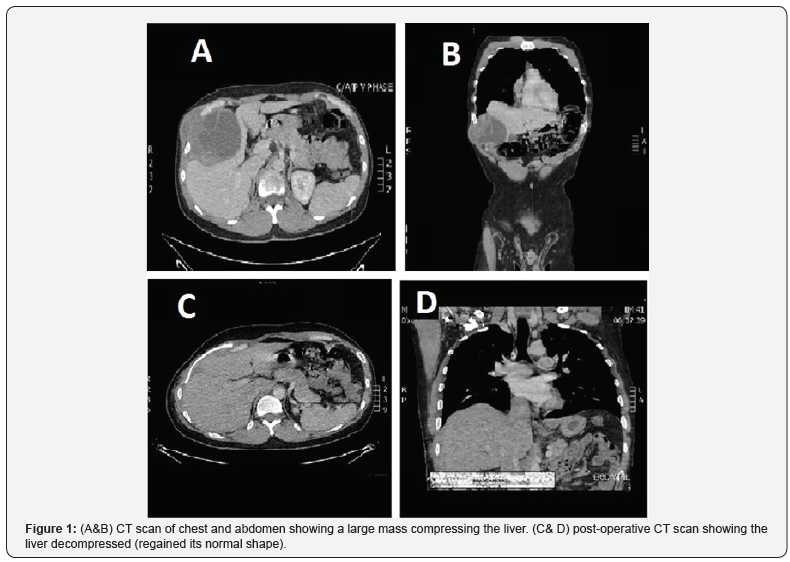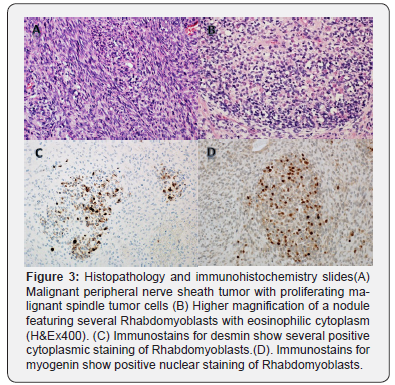A Rare Cause of Massive Hepatic Compression: Thoracic Triton Tumor-Juniper publishers
JUNIPER PUBLISHERS-OPEN ACCESS INTERNATIONAL JOURNAL OF PULMONARY & RESPIRATORY SCIENCES
Abstract
A 30 years old male presented with dry cough, right
hypochondrial pain, tiredness loss of weight and appetite over the last
six months. On clinical examination there was palpable non tender mass
in right hypochondrium, no jaundice or lymphadenopathy. Computed
tomographic scan of chest and abdomen revealed a large mass originating
in the lower chest wall and compressing the liver. True cut biopsy
showed Malignant Peripheral Nerve Sheath Tumor (MPNST).
Introduction
Malignant triton tumor is exceedingly rare subset of MPNST
which displays rhabdomyosarcomatous differentiation. Although
Mason described this first time in 1938 [1] but the actual term
triton was introduced by Woodruff in 1973 based on experimental
work of Locatelli who observed a growth of supernumerary limb
when he transplanted the sciatic nerve on the dorsal surface of
triton salamander [2].
Case
A man aged 32 years, nonsmoker presented with right
hypochondrial pain gradually worsening over the last six months.
There was no history of cough, weight loss or appetite. On clinical
examination there was no cyanosis, jaundice or lymphadenopathy,
there was palpable fixed, nontender mass in right hypochondrium.

Ultrasound of abdomen showed a large mass compressing
the liver. Chest X-ray showed shadow at right lower chest. CT
scan of chest revealed a large 15x10 cm mass compressing the
liver (Figure 1). Basic blood investigations, white cell count,
hemoglobin and renal panels were normal but liver enzymes
were deranged, Alanine Transaminase (ALT) 45u/lit, Aspartate
Transaminase (AST) 24u/LIT, Alkaline Phosphatase 350u/lit. A
true cut biopsy histopathology showed malignant nerve sheath
tumor and further immunohistochemical stain for desmin show
several positive cytoplasmic staining of Rhabdomyoblasts (Figure
2). Further Immunostains for myogenin show positive nuclear
staining of Rhabdomyoblasts which are specific diagnostic
criteria for malignant triton tumor. The case was discussed in
multidisciplinary meeting and recommendation was to proceed
for surgery.


Thoracoabdominal incision (extending from right 8th
intercostal space to subcostal abdominal area) was given and we
found a large tumor arising from 10th intercostal nerve extending
in to abdomen massively compressing the liver fig without any
liver parenchymal infiltration. Tumor was resected enblock with
four ribs and overlying abdominal muscles and part of diaphragm
(Figure 2). The abdominal wall defect was repaired with mesh and
chest wall defect was reconstructed with methyl methacrylate
marlex mesh. Patient was extubated on table and his post-operative
course was uneventful. Patient was followed up in outpatient with
serial CT scan of chest and abdomen and he remained disease free
for one year. Later he developed multiple pulmonary nodules and
biopsy confirmed recurrence of malignant triton tumor and he
was referred to palliative medicine for further care (Figure 3).
Discussion
The tumors arising from a peripheral nerve or pre-existing
nerve sheath tumor such as neurofibroma are all classified by
WHO as MPNST [3]. The MPNST originate from Schwann cells or
pleuripotent cells of neural crest and accounts for 5% of all soft
tissue sarcoma. The incidence of MPNST is 0.001% in general
population and 0.16%in patients with neurofibromatosis type 1
NF1 [4]. Malignant Triton Tumor (MTT) is extremely rare subset
which accounts for < 10% of all MPNST, it commonly occurs in
young population and 50 -70% among those are with NF1 disease
[5,6]. Sporadic cases 20-30% has been reported in older age group
without NF1. These patients are often asymptomatic for long time
unless the tumor enlarges rapidly to cause mass effect or invasion
of surrounding structures.
CT and positron emission tomography scans are the
imaging tools for the initial diagnosis. PET scan is useful to
reveal the distant metastasis in addition to the detail of primary
tumor. The final diagnosis is based on the histological and
immunohistochemical findings [7]. Triton tumor has a very poor
prognosis and recurrence rate is very high after surgery therefore
radical surgical resection with wider clear margins is the mainstay
of treatment. However due to its large size complete removal is
not possible in the anterior mediastinum and patient survival is
poor. Whatever is the location of tumor five year survival rate is
12-14 %. Although the role of radiation and chemotherapy is not
well-defined but still the standard treatment for MTT is radical
excision with wide tumor free margins followed by high dose radiation therapy for better survival. There is large case series
reported about the poor prognosis associated with MTT.
McConnell & Giacomantonio [8] reported after reviewing
the 124 cases of malignant triton tumor that the overall five
years survival rate of 14% and median survival of 13 months
and local recurrence rate was 50% [8]. MTT is rarely reported
in mediastinum, lung and heart (< 10%) [9]. We report a rare
case of thoracic malignant triton tumor arising from intercostal
nerve presented as right hypochondrial pain and massive
liver compression. Initial diagnosis was space occupying liver
lesion. Operative finding showed a giant malignant triton tumor
originating from intercostal nerve and protruding into the
abdomen compressing the liver. Tumor was excised radically
with wider tumor free margins and chest wall was reconstructed.
Patient remained disease free for one year after that he had
multiple metastases in the lung and was referred to palliative care.
In our opinion despite of radical resection with negative margins
unexplained biological behavior merits further research to have
better survival.
To know more about Open Access International
Journal of Pulmonary & Respiratory Sciences please click on: https://juniperpublishers.com/ijoprs/index.php
To know more about Open access Journals
Publishers please click on : Juniper Publishers
To know more about juniper publishers: https://juniperpublishers.business.site/
Comments
Post a Comment